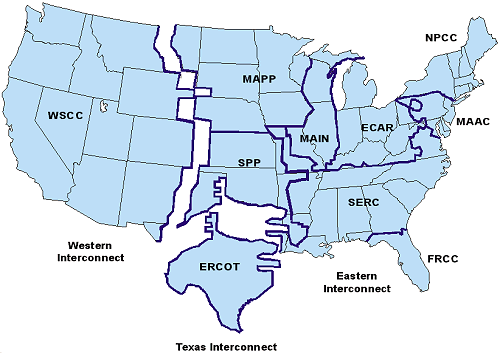 |
It is important to note that there is no "national power grid" in the United States. In fact, the continental United States is divided into three main power grids:
- The Eastern Interconnected System, or the Eastern Interconnect
- The Western Interconnected System, or the Western Interconnect
- The Texas Interconnected System, or the Texas Interconnect.
 The main interconnections of the U.S. electric power grid and the 10 North American Electric Reliability Council (NERC) regions. Note: The Alaska Systems Coordinating Council (ASCC) is an affiliate NERC member. (Source: North American Electric Reliability Council) |
- ECAR — East Central Area Reliability Coordination Agreement
- ERCOT — Electric Reliability Council of Texas
- FRCC — Florida Reliability Coordinating Council
- MAAC — Mid-Atlantic Area Council
- MAIN — Mid-America Interconnected Network
- MAPP — Mid-Continent Area Power Pool
- NPCC — Northeast Power Coordinating Council
- SERC — Southeastern Electric Reliability Council
- SPP — Southwest Power Pool
- WSCC — Western Systems Coordinating Council
The Eastern and Western Interconnects have limited interconnections with each other, and the Texas Interconnect is only linked with the others via direct current lines. Both the Western and Texas Interconnects are linked with Mexico, and the Eastern and Western Interconnects are strongly interconnected with Canada. All electric utilities in the mainland United States are connected with at least one other utility via these power grids.
The grid systems in Hawaii and Alaska are much different than those on the U.S. mainland. Alaska has an interconnected grid system, but it connects only Anchorage, Fairbanks, and the Kenai Peninsula. Much of the rest of the state depends on small diesel generators, although there are a few minigrids in the state as well. Hawaii also depends on minigrids to serve each island's inhabitants.
|

